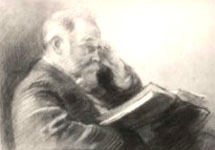Seeing History
Langlois et Seignobos
The new scientific history pioneered in Germany by Ranke and his students did not produce manuals of procedure in its home country. It was rather Charles-Victor Langlois (1863-1929), affectionately called "Charles V" by his students (to get this joke, you have to know some European history) and his colleague Charles Seignobos (1854-1942) who wrote the first comprehensive manual of history on the new scientific principles. This was their Introduction aux Études Historiques. It appeared in 1898, and was translated into English (as Introduction to the Study of History) by G G Berry in 1909. Only two years after that, an American manual in the same spirit was produced by John Martin Vincent at Johns Hopkins. The Langlois et Seignobos manual continued to be the more influential; it was soon translated into Chinese, and was used in the training of academic historians in China up to the middle of the 20th century.
The use of rules in history had previously been satirized by Flaubert in the comic novel Bouvard et Pécuchet. Langlois and Seignobos this had their work cut out for them. Their Authors' Preface spends time refuting the then common notion that the best teaching is not by precept, but by example. They themselves admit, of the most recent of manuals, such as those of Droysen and Freeman, that "the utmost diligence will extract from them nothing in the way of clear ideas beyond the most obvious and commonplace truisms." Their own work of 350 pages obviously aimed to avoid this shortcoming. Its table of contents will show the degree to which philology, the critical examination of the source texts for history, was then accepted as an integral part of the discipline of history. We reproduce that table here:
- Authors' Preface (1)
- Preliminary Studies
- The Search for Documents (17)
- Auxiliary Sciences (42)
- Analytical Operations (63)
- External Criticism
- Textual Criticism (71)
- Critical Investigation of Authorship (87)
- Critical Classification of Sources (101)
- Critical Scholarship and Scholars (112)
- Internal Criticism
- Interpretative Criticism (141)
- Negative Internal Criticism of Authors (155)
- Determination of Particular Facts (191)
- Synthetic Operations
- General Questions of Historical Construction (211)
- The Grouping of Facts (232)
- Constructive Reasoning (252)
- The Construction of General Formulae (262)
- Exposition (296)
- Conclusion (316)
- Appendix 1: Secondary Teaching of History in France (325)
- Appendix 2: The Higher Teaching of History in France (335)
In sum, of the 315 pages of the work proper, a total of 145 pages (46% of the whole) are devoted to the "analytic" operations of source criticism, and 124 pages (39%) to the "synthetic" operations of combining the source information into a historical account. In the authors' view, without the first half of that methodology, to which they themselves devote more than half of their space, there is no second half.
17 Dec 2006 / Contact The Project / Exit to Outline Index Page
